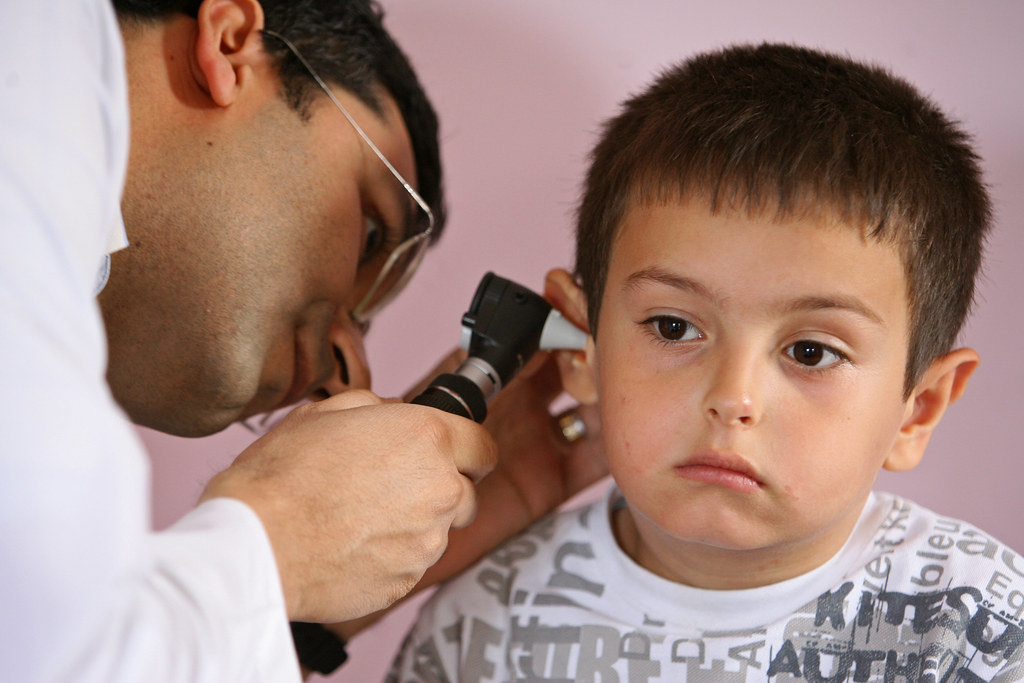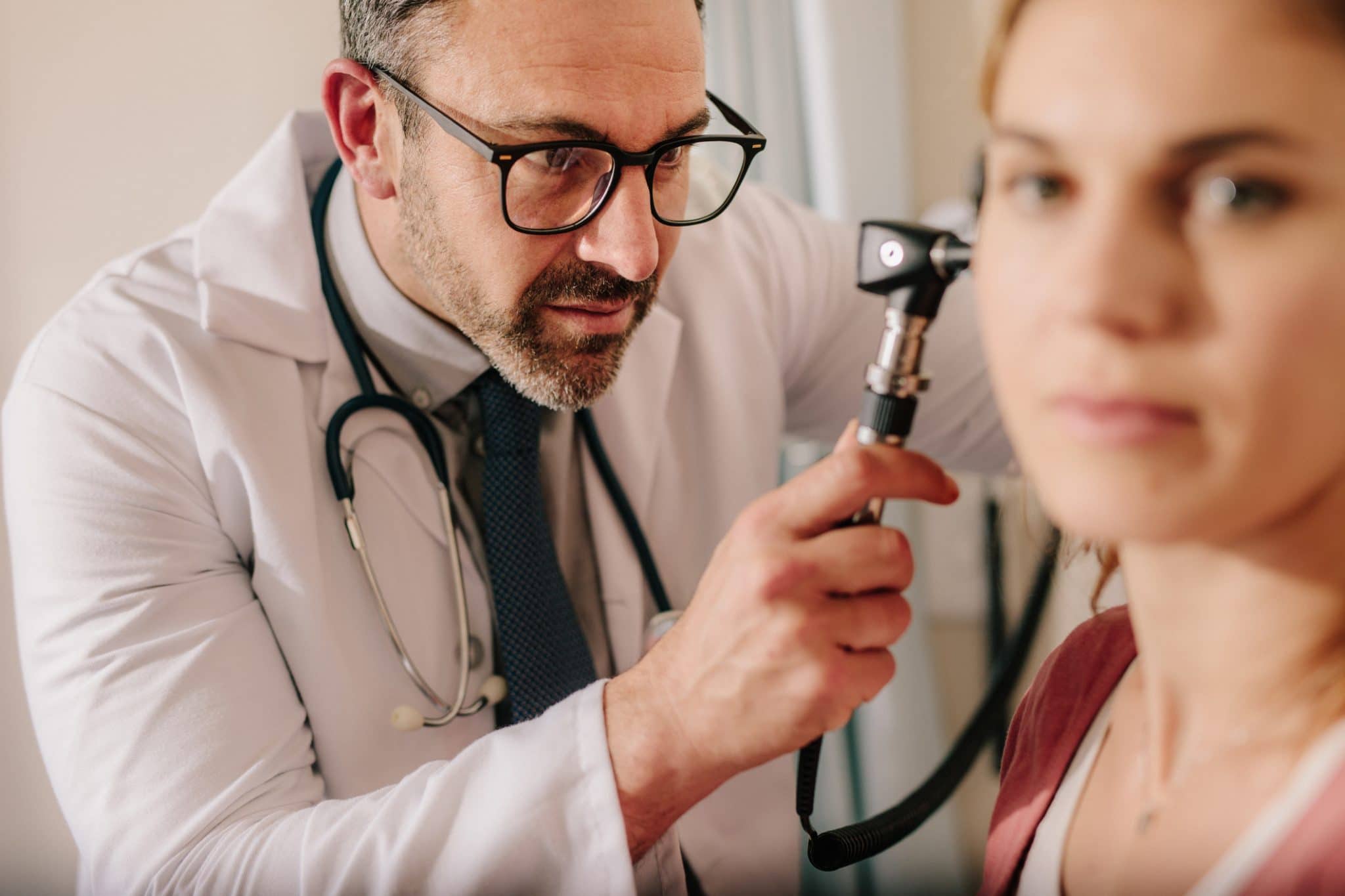Health
Why Is My Ear Hurting Me? 5 Things To Know!

Last Updated on May 9, 2023 by Nurse Vicky
Why Is My Ear Hurting Me? 5 Things To Know!
The question, why is my ear hurting me? There are several possible causes of this problem.
Common causes include Meniere’s disease, TMJ disorders, and a foreign body in the ear canal.
Fortunately, many of these issues can be treated at home. For severe cases, however, you should seek medical attention.
The pain may be related to a more serious condition in some cases. If the pain is very severe or persists, you may need to visit a doctor for a diagnosis.
Ear pain is a common issue affecting people of all ages. Understanding the potential causes and treatments can help you take the necessary steps to alleviate the discomfort.
This comprehensive guide will delve into five common reasons behind ear pain and provide essential information on prevention and treatment.
Meniere’s disease.

The symptoms of Meniere’s disease include ear pain, ear pressure, and a decreased balance response.
The ear pain usually lasts long, and its onset is unpredictable. This condition is also associated with loss of hearing and significant general balance problems.
Fortunately, there are several home remedies for Meniere’s that can reduce symptoms. Read on to learn more.
You’ll also discover some common causes of Meniere’s disease and some tips for treating it.
The symptoms of Meniere’s disease typically appear during the fifth decade of life, although they may also develop in young adults or elderly people.
Males and females are equally susceptible to the disease. In some cases, genetics plays a role. Genetic tests have revealed a link between a person’s hearing loss and Meniere’s disease.
A family history of the disease has also been linked to the development of Meniere’s disease.
Ear Infections
Infections are among the most frequent causes of ear pain. There are two main types of ear infections: middle ear infections and outer ear infections.
Middle Ear Infections (Otitis Media)
Middle ear infections, also known as otitis media, occur when bacteria or viruses infiltrate the middle ear, causing inflammation and pain.
Common symptoms include earache, fever, fluid drainage, and hearing loss. Otitis media is more prevalent in children due to their immature immune systems and the smaller size of their Eustachian tubes.
TMJ Disorders

Sharp pain in the ear may indicate a temporomandibular joint (TMJ) disorder.
TMJ is the joint that connects the jaw and the skull. It can be triggered by grinding your teeth, recent orthodontic work, or arthritis.
If the pain is accompanied by other symptoms, it may be a sign of TMJ. However, if the pain is persistent or occurs on a regular basis, you should consult a doctor.
Earache is often a symptom of a serious illness, such as a sinus infection or TMJ. However, the pain can also result from a complication that doesn’t involve the ear.
Trauma to the head or jaw can also cause ear pain. Traumatic injuries can cause pain in the ear, especially if the eardrum is stretched.
Similarly, the ear can be affected by tooth decay in the back molars, temporomandibular joint pain, or TMJ syndrome.
Outer Ear Infections (Swimmer’s Ear)
Outer ear infections, or swimmer’s ears, are the result of bacterial growth in the outer ear canal. They often occur after swimming or showering, as trapped water in the ear creates a moist environment conducive to bacterial growth.
Symptoms include pain, redness, swelling, and itching in the affected ear. Treatment typically involves antibiotic ear drops and keeping the ear dry.
Eustachian Tube Dysfunction
The Eustachian tubes connect the middle ear to the back of the throat, helping to regulate pressure and drain fluid. Dysfunction occurs when these tubes become blocked or do not open properly, leading to pain, pressure, and hearing difficulties.
Common causes include allergies, colds, and sinus infections. Treatment options range from over-the-counter decongestants to prescription medications or surgical intervention in severe cases.
Foreign Body In The Ear Canal.

When a foreign body gets trapped in the ear, it can irritate and eventually cause damage. Most foreign bodies are placed by the person who has them.
Children are particularly susceptible to this condition. Ear wax and cellular debris can also cause foreign bodies to get trapped in the ear canal.
Excessive use of cotton swabs can push the wax and cellular debris deeper into the ear canal, pressing on the eardrum.
An otolaryngologist will be able to remove the foreign body if it’s large enough to be seen through a microscope.
In some cases, an uncooperative child may need to be sedated to be taken to the doctor. Once the foreign body is removed, it’s unlikely to cause any further damage to the ear
However, if the foreign body is too large or hard to reach, a more invasive method might be necessary.
Middle Ear Infection.
The best way to diagnose a middle ear infection is to visit a doctor.
A doctor can examine the eardrum using a special instrument called an otoscope. This instrument has a magnifying lens and light that will show the fluid behind the eardrum.
The ear should move when the otoscope is placed in the middle ear. If the otoscope shows fluid, the condition is an infection.
Other reasons for ear pain include allergies, colds, or sinus infections. When allergies occur, they can irritate the middle ear tubes, causing fluid to build up.
The fluid can lead to an infection and pain. People who suffer from chronic illnesses are more likely to get an ear infection than those who do not.
While it is common for both children and adults to experience pain, the symptoms of an ear infection are less visible in infants.
Tempromandibular Joint Disorder.

Temporomandibular joint disorder (TMJ) is a common cause of ear pain.
This joint connects the jaw to the skull and is responsible for chewing, swallowing, and speaking.
When this joint becomes irritated, it can lead to a range of problems. Inflammation of the joint can cause the Eustachian tubes to become blocked, affecting hearing.
During a painful episode, pain signals in the jaw joint are transmitted to the brain.
The brain then causes the affected body to react to the pain signal by contracting the muscles surrounding the joint.
If you experience pain in your jaw, it could be related to TMJ. If you suffer from pain in this area, your doctor will likely recommend an X-ray or a joint MRI.
He or she will also examine your bite and look for missing or unusual teeth. In some cases, X-rays and CT scans of the jaw may be necessary to diagnose TMJ.
Your doctor may also order magnetic resonance imaging (MRI) to look for any problems in your jaw or disc.
Earwax Buildup and Impaction
Foreign Objects in the Ear
Inserting foreign objects into the ear, such as cotton swabs or small toys, can cause pain and potential injury to the ear canal or eardrum. Symptoms include pain, hearing loss, and inflammation.
If you suspect a foreign object is lodged in your ear, avoid trying to remove it yourself, as this can cause further damage. Instead, consult a healthcare professional for proper removal.
Barotrauma
Barotrauma refers to the pain and discomfort experienced when there is a difference in pressure between the external environment and the middle ear.
Common situations that cause barotrauma include flying, scuba diving, or driving at high altitudes. Symptoms include ear pain, a feeling of fullness in the ear, and temporary hearing loss.
To prevent barotrauma, practice equalizing techniques such as yawning, swallowing, or using the Valsalva maneuver during pressure changes.
Other Causes of Ear Pain
While the previous sections covered the most common causes of ear pain, several other conditions can lead to discomfort.
These include:
- Ear injuries or trauma
- Skin conditions like eczema or psoriasis affecting the ear
- Dental issues, such as toothaches or gum infections
- Tumors or growths in the ear or surrounding areas
- Nerve-related pain, such as trigeminal neuralgia
How to Treat and Prevent Ear Pain
Depending on the cause of your ear pain, treatment options will vary. In general, you can take the following steps to alleviate discomfort and prevent future occurrences:
- Practice good ear hygiene: Keep your ears clean and dry, but avoid using cotton swabs or inserting anything into the ear canal.
- Treat underlying conditions: Address allergies, sinus infections, or dental issues that may contribute to ear pain.
- Use over-the-counter pain relievers: Non-prescription medications like ibuprofen or acetaminophen can provide temporary relief.
- Apply a warm compress: Place a warm, damp cloth over the affected ear for 15-20 minutes to help alleviate pain.
- Protect your ears during pressure changes: Equalize pressure during activities like flying or diving to prevent barotrauma.
- Consult a healthcare professional: Seek medical help if your symptoms worsen or persist to ensure proper diagnosis and treatment.
When to Seek Medical Help
While mild ear pain may resolve on its own, it’s essential to consult a healthcare professional if you experience any of the following:
- Severe or worsening pain
- High fever
- Swelling or redness around the ear
- Fluid or pus drainage from the ear
- Hearing loss or ringing in the ears
- Dizziness or balance problems
These symptoms may indicate a more serious condition requiring prompt medical attention.
FAQs
1 What can cause sudden ear pain?
Sudden ear pain may result from an ear infection, barotrauma, foreign objects, or a change in pressure due to activities like flying or diving. If the pain persists or worsens, consult a healthcare professional.
2 Can ear pain be a sign of a more serious condition?
While most ear pain is due to common issues like infections or earwax buildup, severe or persistent pain could indicate a more serious condition. Seek medical help if you experience additional symptoms like high fever, swelling, or hearing loss.
3 How can I prevent ear infections?
To prevent ear infections, practice good ear hygiene, keep your ears dry, avoid inserting objects into your ears, and treat underlying conditions like allergies or sinus infections that may contribute to ear problems.
4 Why do children seem to have more ear infections than adults?
Children are more prone to ear infections due to their developing immune systems and the smaller size of their Eustachian tubes, which makes them more susceptible to blockage.
5 Can ear pain be caused by a toothache?
Yes, dental issues like toothaches or gum infections can cause referred pain in the ear due to the close proximity of nerves in the face and jaw.
6 How can I safely clean my ears?
To clean your ears safely, gently wipe the outer part of your ear with a damp washcloth. Avoid using cotton swabs or inserting anything into the ear canal, as this can push earwax further in or cause injury.
7 Why does my ear hurt when I swallow?
Ear pain when swallowing could be due to Eustachian tube dysfunction, as the act of swallowing helps equalize pressure in the middle ear. Infections or inflammation in the throat may also cause referred pain in the ear.
8 Is it normal to have ear pain after using headphones or earbuds?
While occasional discomfort from wearing headphones or earbuds may be normal, persistent ear pain could indicate that the volume is too high, the fit is too tight, or there is an underlying issue like an infection or earwax buildup.
9 Can cold weather cause ear pain?
Cold weather can cause ear pain by constricting blood vessels in the ear and making the skin more sensitive. To prevent cold-induced ear pain, wear appropriate ear protection like earmuffs or a warm hat when outdoors in cold temperatures.
10 How long does it take for ear pain to go away?
The duration of ear pain depends on the cause and the treatment. For mild cases, ear pain may resolve within a few days. However, more severe or persistent cases may require medical intervention and can take longer to heal.
Ear pain can result from various causes, including infections, Eustachian tube dysfunction, TMJ, earwax buildup, and foreign objects. Understanding the underlying cause and seeking appropriate treatment can help you find relief and prevent future occurrences. Consult a healthcare professional if you experience severe or persistent ear pain.
Health
Hair Gummies: A Trend Worth Your Time or Just Another Health Fad?

Hair Gummies: A Trend Worth Your Time or Just Another Health Fad?
In recent years, hair gummies have taken the health and beauty world by storm, boasting promises of luscious locks and a speedy route to hair health.
But with an array of products flooding the market, it’s essential to separate fact from fiction.
Are these colorful, chewy supplements a miracle solution for your hair troubles, or are they simply a trendy snack with little efficacy?
In this comprehensive article, we will explore the science behind hair gummies, their ingredients, potential benefits, and the questions surrounding their effectiveness.
Understanding Hair Health
The Basics of Hair Growth
To fully grasp the impact of hair gummies, it’s vital to understand how hair grows.
Each strand of hair goes through three main phases:
- Anagen Phase: This is the active growth phase, which can last several years. The length of this phase varies among individuals.
- Catagen Phase: A transitional phase lasting a few weeks, where hair growth slows, and the hair follicle shrinks.
- Telogen Phase: The resting phase, lasting a few months before the hair falls out, making way for new growth.
Hair health is influenced by a variety of factors, including genetics, hormones, diet, and overall health.
As such, a balanced approach to hair care, encompassing nutrition, proper hair care routines, and avoiding damaging practices, is essential.
Common Causes of Hair Issues
Hair loss or poor hair health can arise from numerous factors:
- Nutritional Deficiencies: A lack of essential vitamins and minerals can hinder hair growth.
- Hormonal Changes: Conditions like pregnancy, menopause, and thyroid disorders can significantly affect hair health.
- Stress: Chronic stress can trigger hair loss through a condition known as telogen effluvium.
- Medical Conditions: Certain diseases and medications can also contribute to hair loss.
What Are Hair Gummies?
Hair gummies are dietary supplements designed to promote hair health.
They are usually made with a combination of vitamins, minerals, and sometimes botanical extracts, often marketed as a convenient and tasty alternative to traditional vitamin pills.
Key Ingredients in Hair Gummies
While formulations vary, here are some common ingredients found in hair gummies:
- Biotin: A B-vitamin known for its role in hair and nail health. Biotin deficiencies can lead to brittle hair and hair loss.
- Vitamins A, C, and E: Antioxidants that help protect hair from oxidative stress, promoting a healthy scalp and hair growth.
- Folic Acid: Important for cell growth and regeneration, folic acid is believed to support healthy hair follicles.
- Zinc: Plays a role in hair tissue growth and repair, making it a crucial mineral for maintaining healthy hair.
- Collagen: An essential protein for skin elasticity that may also benefit hair strength and growth.
Do Hair Gummies Really Work?
The Science Behind Hair Gummies
While the ingredients in hair gummies are known to contribute to hair health, the question remains:
Do they work as effectively as claimed?
Here’s what the research suggests:
- Biotin: Studies have shown that biotin can improve hair thickness in those with deficiencies, but most people get sufficient biotin from their diet. Supplementing with biotin may not yield significant benefits for individuals who are not deficient.
- Vitamins and Minerals: Research indicates that vitamins A, C, D, E, and minerals like zinc and iron play a role in maintaining healthy hair. However, simply taking these vitamins in gummy form doesn’t guarantee results unless there’s a deficiency present.
- Collagen: Some studies suggest that collagen supplements can improve hair and skin health by providing amino acids essential for protein synthesis. However, more research is needed to establish direct benefits for hair growth.
User Experiences and Anecdotes
While anecdotal evidence often highlights positive experiences with hair gummies, it’s important to approach these testimonials with caution. Individual results may vary, and factors such as diet, overall health, and genetics play significant roles in hair health.
Potential Benefits of Hair Gummies
While not a miracle solution, hair gummies may offer certain benefits:
- Convenient Form: For those who struggle with swallowing pills, gummies provide a palatable alternative.
- Added Nutrients: If you have a deficiency in specific vitamins or minerals, hair gummies can supplement your diet effectively.
- Increased Awareness of Nutrition: Taking supplements can prompt individuals to pay more attention to their overall nutritional intake.
- Improved Hair Appearance: Users may notice shinier and healthier-looking hair due to the vitamins and antioxidants present in these products.
Are There Risks?
While hair gummies are generally safe, there are some considerations to keep in mind:
- Overconsumption: Gummies are often flavored and sweetened, which may lead to overconsumption and potential digestive issues.
- Sugar Content: Many gummies contain added sugars, which can contribute to other health problems if consumed excessively.
- Interactions with Other Supplements: If you’re taking other vitamins or supplements, it’s essential to ensure you’re not exceeding recommended doses, particularly for fat-soluble vitamins like A and E, which can accumulate in the body.
What Experts Say
Dermatologists and nutritionists often emphasize a balanced diet over reliance on supplements.
They suggest that whole foods—rich in vitamins, minerals, and healthy fats—are the best source for hair health.
Foods such as leafy greens, nuts, seeds, fish, and eggs can provide essential nutrients without the added sugars and potential downsides of gummies.
Conclusion:
Fad or Fact?
In conclusion, hair gummies may not be the ultimate solution for hair health, but they can serve as a helpful supplement for those with specific nutritional deficiencies.
They are convenient and may improve the overall appearance of hair for some users. However, it’s crucial to approach them with realistic expectations and prioritize a balanced diet rich in whole foods.
If you’re considering adding hair gummies to your routine, consult with a healthcare provider or nutritionist to ensure you’re making an informed decision that aligns with your health goals.
FAQs
1. Can hair gummies replace a balanced diet?
No, hair gummies are supplements and should not replace a balanced diet. They can help fill nutritional gaps but should be taken alongside a healthy eating plan.
2. How long does it take to see results from hair gummies?
Results vary, but users may start noticing improvements in hair texture and appearance after 4-12 weeks of consistent use.
3. Are hair gummies safe for everyone?
Most hair gummies are safe for general use; however, individuals with specific health conditions or allergies should consult a healthcare professional before taking them.
4. Can I take hair gummies with other supplements?
Yes, but be cautious of total vitamin and mineral intake to avoid exceeding recommended daily allowances. Consult with a healthcare provider for personalized advice.
5. Are there any side effects of hair gummies?
Some users may experience digestive issues, allergic reactions, or headaches due to high sugar content or specific ingredients. It’s best to start with a small dose to assess tolerance.
References:
Health
Understanding the Spine: Common Conditions and Effective Solutions

Understanding the Spine: Common Conditions and Effective Solutions
The spine is an essential structure in the human body, acting as a central pillar that supports our posture, facilitates movement, and protects the spinal cord.
Despite its importance, many individuals experience various spine-related conditions that can impact their quality of life.
In this comprehensive article, we will explore common spinal conditions, their causes, symptoms, and effective methods to address them.
What is the Spine?
The spine, also known as the vertebral column, is composed of 33 vertebrae arranged in a flexible yet sturdy structure.
It serves several critical functions:
- Support: The spine supports the head and allows for an upright posture.
- Protection: It encases and protects the spinal cord, a crucial component of the central nervous system.
- Mobility: The spine allows for a wide range of movements, including bending, twisting, and turning.
- Weight Distribution: It helps distribute weight and absorbs shock during activities like walking or running.
Understanding the structure and function of the spine is vital for recognizing and addressing the conditions that can affect it.
Common Spinal Conditions
Several conditions can adversely impact the spine, leading to pain, discomfort, and reduced mobility. Here are some of the most common spinal conditions:
1. Herniated Discs
A herniated disc occurs when the soft inner material of a spinal disc bulges out through a tear in the outer layer. This can compress nearby nerves, leading to pain, numbness, or weakness in the arms or legs.
Causes:
- Age-related degeneration
- Heavy lifting or sudden movements
- Trauma or injury
Symptoms:
- Localized back pain
- Radiating pain to the limbs
- Numbness or tingling
Treatment:
- Physical therapy
- Pain management through medications
- In severe cases, surgery may be required.
2. Spinal Stenosis
Spinal stenosis is the narrowing of the spinal canal, which can lead to pressure on the spinal cord and nerves. This condition often occurs in the cervical (neck) or lumbar (lower back) regions.
Causes:
- Age-related changes in the spine
- Osteoarthritis
- Herniated discs
Symptoms:
- Pain or cramping in the legs
- Weakness or numbness
- Difficulty walking or standing for extended periods
Treatment:
- Physical therapy and exercise
- Medications for pain relief
- In some cases, surgical decompression may be necessary.
3. Scoliosis
Scoliosis is an abnormal curvature of the spine, often appearing in childhood or adolescence. While many cases are mild, severe scoliosis can lead to complications.
Causes:
- Idiopathic (unknown cause)
- Congenital (present at birth)
- Neuromuscular conditions
Symptoms:
- Uneven shoulders or hips
- Visible curvature of the spine
- Back pain
Treatment:
- Monitoring and observation for mild cases
- Bracing for growing children
- Surgery for severe curvatures.
4. Osteoporosis
Osteoporosis is a condition characterized by weakened bones, making them more susceptible to fractures. This is particularly concerning for the vertebrae, which can lead to compression fractures.
Causes:
- Aging
- Hormonal changes
- Lack of calcium and vitamin D
Symptoms:
- Height loss
- Back pain due to fractures
- A stooped posture
Treatment:
- Medications to strengthen bones
- Nutritional supplements (calcium and vitamin D)
- Weight-bearing exercises to improve bone density.
5. Degenerative Disc Disease
Degenerative disc disease refers to the wear and tear of spinal discs over time, leading to pain and reduced flexibility.
Causes:
- Age-related degeneration
- Repetitive stress on the spine
- Genetics
Symptoms:
- Chronic back pain
- Pain that worsens with movement
- Possible radiating pain in the limbs
Treatment:
- Physical therapy and exercise
- Pain management strategies
- Surgical options for severe cases.
Preventing Spinal Conditions
While some spinal conditions are unavoidable due to genetics or aging, many can be prevented or mitigated through healthy lifestyle choices.
Here are some preventative measures:
1. Maintain Good Posture
Proper posture helps reduce strain on the spine. When sitting, keep your back straight, shoulders relaxed, and feet flat on the ground. When standing, distribute your weight evenly on both feet.
2. Stay Active
Regular physical activity strengthens the muscles that support the spine and improves flexibility. Aim for a balanced routine that includes strength training, aerobic exercise, and stretching.
3. Ergonomic Work Environment
If you spend long hours at a desk, ensure your workspace is ergonomically designed. Adjust your chair, desk height, and computer monitor to reduce strain on your back and neck.
4. Healthy Weight Management
Maintaining a healthy weight reduces stress on the spine and helps prevent conditions like degenerative disc disease and spinal stenosis.
5. Avoid Smoking
Smoking impairs blood flow and can lead to spinal degeneration. Quitting smoking can improve overall health and reduce the risk of spinal issues.
Effective Treatments for Spinal Conditions
If you experience spine-related pain or discomfort, it’s essential to consult a healthcare professional for a proper diagnosis and treatment plan.
Here are some common treatment options:
1. Physical Therapy
Physical therapists develop personalized exercise programs to strengthen the back muscles, improve flexibility, and alleviate pain. They may also use techniques like ultrasound or electrical stimulation to manage discomfort.
2. Medications
Over-the-counter pain relievers, such as ibuprofen or acetaminophen, can help manage mild to moderate pain. Prescription medications may be necessary for more severe pain or inflammation.
3. Injections
Corticosteroid injections can reduce inflammation and provide temporary relief for conditions like herniated discs or spinal stenosis. These are typically used when other treatments have failed.
4. Surgery
In severe cases, surgery may be necessary to relieve pressure on the spinal cord or nerves. Common surgical procedures include discectomy (removal of herniated disc material), spinal fusion, and laminectomy (removal of part of the vertebra).
5. Alternative Therapies
Complementary treatments like acupuncture, chiropractic care, and massage therapy may provide relief for some individuals. Always consult with a healthcare professional before trying alternative therapies.
Conclusion
Understanding the spine and its common conditions is crucial for maintaining a healthy lifestyle and preventing potential issues.
By recognizing symptoms early and seeking appropriate treatment, individuals can address spinal conditions effectively.
Implementing preventative measures, such as maintaining good posture and staying active, can significantly reduce the risk of developing spine-related issues.
Prioritize your spinal health, consult with professionals when necessary, and take proactive steps to ensure a healthy and pain-free back.
FAQs
1. What are the common symptoms of spinal conditions?
Common symptoms include localized back pain, radiating pain in the limbs, numbness, tingling sensations, and difficulty with movement.
2. How can I improve my posture while working?
To improve your posture at work, adjust your chair and desk height, use a supportive chair, and ensure your computer screen is at eye level.
3. Can physical therapy help with spinal conditions?
Yes, physical therapy can help strengthen back muscles, improve flexibility, and alleviate pain associated with various spinal conditions.
4. When should I see a doctor for back pain?
If you experience persistent back pain that does not improve with rest, is accompanied by numbness or weakness, or interferes with daily activities, it’s essential to see a doctor.
5. Are there lifestyle changes I can make to prevent spinal issues?
Yes, maintaining a healthy weight, staying active, practicing good posture, and avoiding smoking can help prevent spinal conditions.
References:
Health
Understanding the Causes of Premature Menopause in Women
-

 Trending Stories1 year ago
Trending Stories1 year agoCDC: 1 in 4 Americans Still COVID-Free by End of 2022
-

 Health5 years ago
Health5 years agoMeghan Trainor Shares Motivational New Song ‘Blink’
-

 Health6 months ago
Health6 months agoHow Do Pawpaw Seeds Support Cardiovascular Health?
-

 Health2 years ago
Health2 years agoHow Long Does Monkey Pox Last Before It Surfaces in the Body?
-

 Health3 years ago
Health3 years agoWhat Causes Swollen Body? Understanding Edema and its Triggers
-

 Health3 years ago
Health3 years agoNutrition and the Importance of a Fitness Program – 3 Things to Know
-

 Health3 years ago
Health3 years ago5 Weird Reasons Why Pimples Disappear After Marriage
-

 Health2 years ago
Health2 years agoHealth Benefits Of Pawpaw Seed? 7 Things To Know






